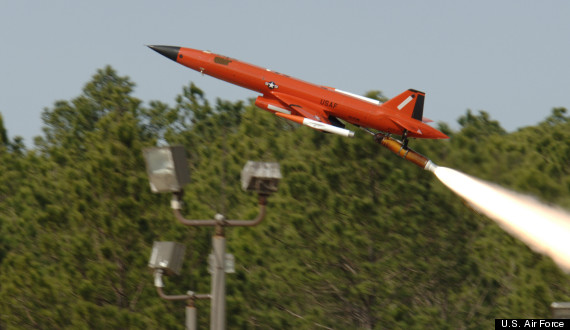Boaters in the Florida Keys were alarmed over the weekend when they came across what looked like a very large piece of military ordnance floating about a mile from the Port Largo Canal.
The Coast Guard was called. Onlookers remained at a distance for safety. And the answer surprised everyone.
As first reported by the Florida Keys Keynoter, it turns out the bright orange, 20-foot long, missile-shaped object was a $570,000 Air Force drone that had been shot down during a training mission in January -- 800 miles away, near Tyndall Air Force base in the Florida Panhandle.
"As soon as we heard, we had people on the way," Lt. Col. Lance Wilkins, commander of Tyndall's 82nd Aerial Targets Squadron, told the Keynoter, explaining that the Air Force would repair and reuse the drone.
According to an official fact sheet, the BQM-167 drone is "a high-performance, remotely-controlled subscale aerial target used to provide a threat-representative target drone to support the Air-to-Air Weapon System Evaluation Program and other Air Force and Department of Defense air-to-air test and evaluation programs."
NBC News reports that Tyndall airmen have launched BQM-167s about 600 times since 2007, according to Wilkins, initially losing 16 of them at sea. Of the missing, nine were later recovered.
The others, like the Keys drone, presumably slipped into currents in the Gulf of Mexico and headed to sea.
"You would think that they would have awesome beacon tracking or at least GPS enabled on the thing," Roger Grimes, one the boaters who radioed the Coast Guard, told the Keynoter.
And who can blame South Floridians for being cautious? In 2011, a live Navy mine washed ashore in Miami Beach, causing the bomb squad to evacuate the sand.
A month later, a Miami Gardens family found a live grenade in their backyard.
UPDATE, Friday noon: Lt. Col. Lance Wilkins, commander of Tyndall's 82nd Aerial Targets Squadron, told HuffPost that the drones used for live fire exercises -- including the one that floated to the Keys -- are equipped with a tracking beacon.
But batteries don't last forever, he said, and the drone's GPS can be "thwacked" out of service when struck by an anti-drone practice missile traveling at several thousand miles per hour.
Though boats are pre-positioned to retrieve the drones after an exercise, weather doesn't always cooperate with a safe recovery.
"For us to recover these we have to have weather that is acceptable risk," Wilkins said, "because we have to put a diver in the water to hook up the drone and get it on the back of the boat."
Wilkins told HuffPost the Air Force has been using the types of drones launched for live fire exercises since the 1950s, and his unit will attempt to retrieve a fallen drone three days in a row before damage from prolonged exposure usually sinks them.
One of the BQM-167 drones in action: 
